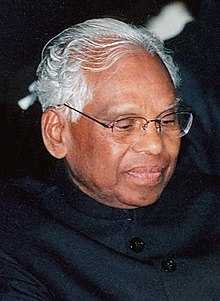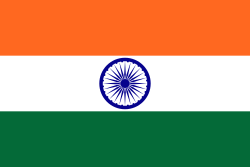K.R. Narayanan
| Hans Excellence K. R. Narayanan | |
|---|---|
 K. R. Narayanan i 2000 | |
| Indiens 10. præsident | |
| Embedsperiode 25. juli 1997 – 25. juli 2002 | |
| Premierminister | I. K. Gujral Atal Bihari Vajpayee |
| Vicepræsident | Krishan Kant |
| Foregående | Shankar Dayal Sharma |
| Efterfulgt af | Abdul Kalam |
| Indiens 9. vicepræsident | |
| Embedsperiode 27. oktober 1992 – 24. juli 1997 | |
| Præsident | Shankar Dayal Sharma |
| Foregående | Shankar Dayal Sharma |
| Efterfulgt af | Krishan Kant |
| Personlige detaljer | |
| Født | 27. oktober 1920 Uzhavoor, Kerala, Indien |
| Død | 9. november 2005 (85 år) New Delhi, Delhi, Indien |
| Dødsårsag | Lungebetændelse |
| Politisk parti | Indian National Congress |
| Ægtefælle | Usha Narayanan |
| Uddannelsessted | Kerala Universitet London School of Economics |
| Religion | Hinduisme |
| Underskrift |  |
| Informationen kan være hentet fra Wikidata. | |
Kocheril Raman Narayanan også kendt som K. R. Narayanan (27. oktober 1920 i Travancore - 9. november 2005 i New Delhi) var Indiens præsident fra 1997 til 2002. Han var den tiende præsident i Indien efter uafhængigheden fra Storbritannien i august 1947.[1]
Han begyndte sin politiske karriere i Indien som medlem af den indiske udenrigstjeneste under administrationen til Jawaharlal Nehru. Han fungerede også som Indiens ambassadør i Japan, Storbritannien, Thailand, Tyrkiet, Kina og USA og blev beskrevet af Nehru som «den bedste diplomat i landet». Han blev valgt som Indiens vicepræsident i 1992 og gik videre fra vicepræsident til selv at blive præsident for Indien i 1997.
Referencer
- ^ "Former Presidents". The President of India. Hentet 15. oktober 2019.
| ||||||
| ||||||||
| Spire |
|
Medier brugt på denne side
The National Emblem of India is derived from the time of the Emperor Ashoka. The emblem is a replica of the Lion of Sarnath, near Varanasi in Uttar Pradesh. The Lion Capital was erected in the third century BC by Emperor Ashoka to mark the spot where Buddha first proclaimed his gospel of peace and emancipation to the four quarters of the universe. The national emblem is thus symbolic of contemporary India’s reaffirmation of its ancient commitment to world peace and goodwill. The four lions(one hidden from view ) – symbolising power, courage and confidence- rest on a circular abacus. The abacus is girded by four smaller animals—Guardians of the four directions: The Lion of the North, The Horse of the West, The Bull of the South and The Elephant of the East. The abacus rests on a lotus in full bloom, exemplifying the fountainhead of life and creative inspiration. The motto 'Satyameva Jayate' inscribed below the emblem in Devanagari script means 'truth alone triumphs'.
Forfatter/Opretter: K R Narayanan, digitalization by Hindustanilanguage, Licens: CC BY-SA 3.0
K R Narayanan's Autograph
K.R. Narayanan, Former President of the Republic of India




